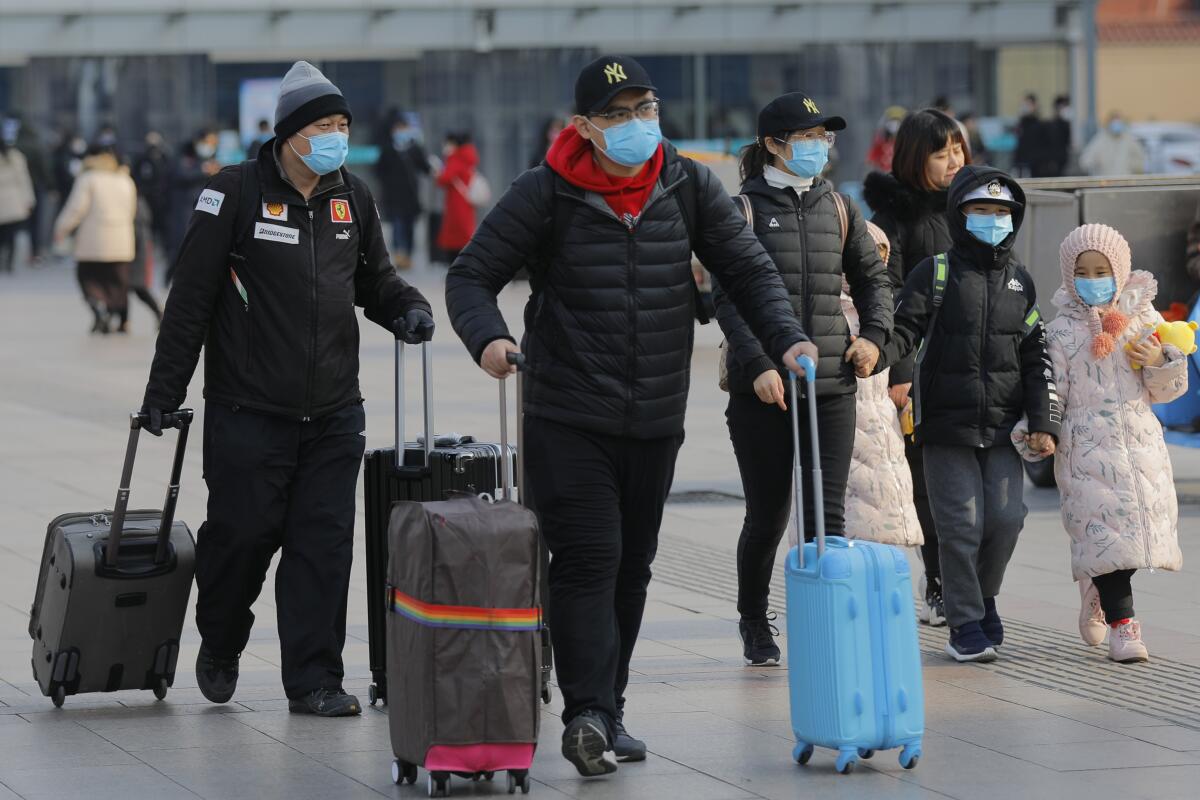The new coronavirus isn’t a threat to people in the United States — but flu is

- Share via
It’s not just in China. Many people in U.S. cities are out on the street today wearing paper masks, hoping they will provide a barrier to respiratory droplets. The masks have been donned in the belief that a new and dangerous coronavirus has not only landed on our shores, but also is likely to infect them at any time.
I am not usually one to criticize public health measures, but this one is overkill. Surgical masks aren’t just an inadequate protection against viral spread; the masks also signal that we should be deathly afraid of something that does not currently pose a threat and may well never do so.
Although the novel coronavirus has, as of Wednesday, infected at least 6,000 people in China, killing 130, there are only two cases in California as of Wednesday and five in the entire United States. And the Centers for Disease Control and Prevention has been vigilant about screening symptomatic travelers (now at 20 airports) coming here from affected areas in China.
With new health risks, it is always a balancing act between underreaction and overreaction. Dr. Anthony Fauci, longtime director of the National Institute of Allergy and Infectious Diseases, grapples with that issue all the time.
“It’s our job to be very transparent … [without] exaggerating anything and instilling fear when there doesn’t need to be,” he told me last night. In this case, he said, “I think we can say right now, given what’s going on, that the risk to the American public is low. But that doesn’t mean they shouldn’t be taking this situation very seriously, which is what we as health authorities are doing.”
Fauci says he thinks the CDC has done an excellent job of identifying, isolating and tracing contacts of people in the U.S. with the potential to be harboring the virus. At the same time, he says he remains deeply concerned about what’s taking place in China. “The way the trajectory is going now,” he said, “I see that it is likely to continue to get worse before it gets any better.”
There is reason to believe there may have been thousands more cases in China than have been reported, and there is evidence that the novel coronavirus has been there for months, spreading from human to human. It is the definition of poor public health that China has gone from underreacting to locking down an entire region of close to 60 million people, along with massive quarantines and travel restrictions. Historically, it has never been shown that regional quarantine completely stops the spread of a killer bacteria or virus, as people tend to take fewer precautions when they are afraid and do their best to escape confinement.
It no longer matters which exotic mammal this coronavirus originated from. As a single-stranded RNA pathogen, coronaviruses are highly unstable, rapidly mutating, and close contact with humans increases the chance that a version capable of infecting humans will emerge.
We saw this with Severe Acute Respiratory Syndrome (SARS) back in 2002, another coronavirus that emerged in China (moving from bats to civet cats to people) and went on to infect nearly 8,000 people, killing close to 800. The Wuhan coronavirus looks like it is somewhat more contagious, though less deadly. In both cases the virus spread because of suppressed information, inadequate identification and isolation, and poor public health infrastructure.
We have a long way to go before we contain this coronavirus, but severe travel restrictions are a good place to start. The State Department is urging Americans to reconsider travel to China at this point, which seems like excellent advice if for no other reason than that the Chinese government may decide not to let you come home.
But while we are worrying about the Wuhan virus, it is extremely important that we not ignore another single-stranded, frequently mutating RNA virus transmitted by coughing and sneezing and touching. In fact, this virus has already infected close to 20 million people here in the U.S. this year alone, and killed more than 8,000. The virus, known as influenza, kills more than half a million people worldwide every year, though too many of us take it for granted.
But with influenza, we have an effective treatment, a fairly effective vaccine, and we know the public health numerator (number of cases and deaths) and the denominator (number of people at risk of getting it). For coronavirus, there is much we still don’t know, including how easily it may spread before those infected have symptoms of fever, cough, or sore throat.
It is the unknown that scares us, even though the risk to people in the United States, as Fauci says, remains very low at this point. He also notes that there are several vaccine candidates due to enter clinical trials soon, and an effective vaccine will provide an antidote against both the virus and our fear of the virus.
But human minds jump to worst case scenarios. I wish I could convince someone walking down the street in Los Angeles today that he or she is a million times more likely to encounter the flu virus than the new coronavirus, but I know that the emotional center — the hard wiring of the brain — is too strong, fed as it is by news-stoked fears.
Marc Siegel is a professor of medicine and medical director of Doctor Radio at NYU Langone Health. He is the author of several books on disease outbreaks including “False Alarm: The Truth About the Epidemic of Fear.”
More to Read
A cure for the common opinion
Get thought-provoking perspectives with our weekly newsletter.
You may occasionally receive promotional content from the Los Angeles Times.









